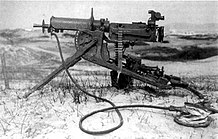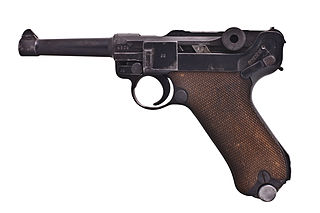
The Pistole Parabellum or Parabellum-Pistole, commonly known as just the Luger or Luger P08, is a toggle-locked recoil-operated semi-automatic pistol. The Luger was produced in several models and by several nations from 1898 to 1949.
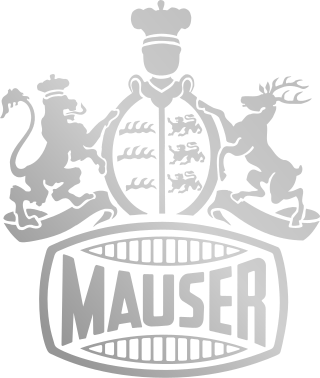
Mauser, originally the Königlich Württembergische Gewehrfabrik, was a German arms manufacturer. Their line of bolt-action rifles and semi-automatic pistols was produced beginning in the 1870s for the German armed forces. In the late 19th and early 20th centuries, Mauser designs were also exported and licensed to many countries, which adopted them as military and civilian sporting firearms. The Gewehr 98 in particular was widely adopted and copied, and it is the foundation of many of today's sporting bolt-action rifles.
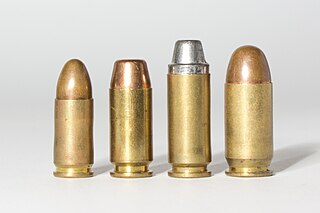
The 9×19mm Parabellum is a rimless, tapered firearms cartridge.

The Maschinengewehr 08, or MG 08, was the German Army's standard machine gun in World War I and is an adaptation of Hiram S. Maxim's original 1884 Maxim gun. It was produced in a number of variants during the war. The MG 08 served during World War II as a heavy machine gun in many German infantry divisions, although by the end of the war it had mostly been relegated to second-rate fortress units.

The Gewehr 98 is a bolt-action rifle made by Mauser for the German Empire as its service rifle from 1898 to 1935.

Georg Johann Luger was an Austrian designer of the famous Luger pistol and the 9×19mm Parabellum cartridge.
Ludwig Loewe was a German merchant, manufacturer, philanthropist and a member of the Reichstag. Loewe's companies became involved in the production of armaments, employing famous designers and creating notable guns.

The Borchardt C93 is a semi-automatic pistol designed by Hugo Borchardt in 1893.

The Parabellum MG 14 was a 7.92 mm caliber World War I machine gun built by Deutsche Waffen und Munitionsfabriken. It was a redesign of the Maschinengewehr 08 machine gun system intended for use on aircraft and zeppelins. Like the earlier Vickers machine gun, it used a toggle action that broke upwards rather than downwards, the opposite way to the MG 08, making for a much more compact receiver. The fusee spring was replaced with an internal spring design, the breech block was completely different and the spent cartridges dropped out the bottom of the receiver, rather than being ejected forward through a hole under the breech from the receiver. There appears to be no action or receiver parts interchangeable with the MG 08. The MG 08's belt-style ammunition feed was enclosed in a drum, the recoil casing was lightened and the cooling jacket was modified for air- instead of water-cooling. The rate of fire was 700 rounds/minute. The belt was reduced to 30 mm in width.

The 7.65×25mm Borchardt cartridge was designed by Georg Johann Luger for use in Hugo Borchardt's Borchardt C-93 pistol. It was the first successful rimless pistol cartridge.
The Mauser–Vergueiro was a bolt-action rifle, designed in 1904 by José Alberto Vergueiro, an infantry officer of the Portuguese Army, and manufactured by Deutsche Waffen und Munitionsfabriken (DWM). It was developed from the Mauser 98 rifle with the introduction of a new bolt system derived from the Gewehr 1888 and Mannlicher–Schönauer. Outside Portugal, the weapon was also known as the Portuguese Mauser. It used the 6.5×58mm Vergueiro, a cartridge developed specially for it.

The 9×25mm Mauser is a cartridge developed for the Mauser C96 service pistol around 1904 by DWM. Mauser pistols in this relatively powerful caliber were primarily intended for export to Africa, Asia, and South America. The 9mm Mauser Export cartridge was produced specifically for Mauser pistols and carbines made from 1904 to 1914 and then later from approximately 1930 to 1945 for submachine guns chambered for this caliber.

The Maschinengewehr Modell 1911 or MG 11 is a Swiss heavy machine gun which was introduced before and during World War I. The MG 11 has a close constructive relationship with the German MG 08 heavy machine gun.

Waggon Union was a German manufacturer of rail vehicles and bus bodies, that was also known as Deutsche Waggon und Maschinenfabrik or DWM.
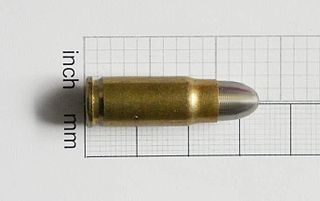
The 7.63×25mm Mauser round was the original cartridge for the Mauser C96 service pistol. This cartridge headspaces on the shoulder of the case. It later served as the basis for the 7.62mm Tokarev cartridge commonly used in Soviet and Eastern Bloc weapons.

The 7.65×21mm Parabellum is a pistol cartridge that was introduced in 1898 by German arms manufacturer Deutsche Waffen- und Munitionsfabriken (DWM) for their new Pistol Parabellum. The primary developers of the pistol cartridge were firearms designers Georg Luger and Hugo Borchardt, who developed the round from the earlier 7.65×25mm Borchardt while working at DWM.

The Mauser Model 1895 is a bolt operated magazine fed rifle using the 7×57mm Mauser cartridge. It was exported to many overseas powers, including the Chilean forces which adopted as the Fusil Mauser Chileno Modelo 1895. It is the first major modification of the Mauser Model 1893 and was produced by Deutsche Waffen und Munitionsfabriken, known as DWM, and Ludwig Loewe Company from 1895 to 1900.
The Mauser Model 1904 and Model 1907 were Gewehr 98 pattern bolt-action rifles produced by Mauser and Deutsche Waffen und Munitionsfabriken (DWM). They were designed for export market. Copies were later produced in China and in Spain.

